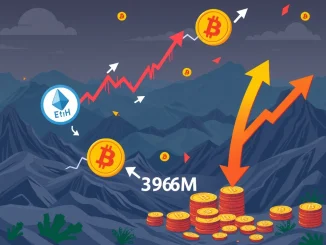
Exciting news for the Ethereum restaking world! EigenLayer, the platform that ignited the restaking craze and currently boasts over $15 billion in value, is set to launch its highly anticipated slashing feature on April 17th. This update isn’t just another tick on the roadmap; it’s a fundamental piece of the puzzle, completing EigenLayer’s core protocol functionality and addressing key concerns within the community. If you’re invested in the future of Ethereum and decentralized security, this is an update you absolutely need to understand.
Why is EigenLayer’s Slashing Feature a Game Changer for Ethereum Restaking?
EigenLayer has become synonymous with Ethereum restaking, allowing users to restake their ETH to secure not only the Ethereum network but also a growing ecosystem of Actively Validated Services (AVSs). Think of AVSs as decentralized applications or middleware layers that require security and validation. EigenLayer provides this shared security, making it easier and more efficient for new projects to launch and scale within the Ethereum ecosystem. But, with great power comes great responsibility, and that’s where slashing enters the picture.
Slashing, in simple terms, is a mechanism to penalize node operators who aren’t performing their duties correctly. Imagine it like this:
- Accountability Boost: Just like any service provider, node operators in AVSs need to be held accountable. Slashing introduces financial penalties for underperformance or malicious behavior.
- Enhanced Security: By deterring bad actors and incentivizing good behavior, slashing significantly strengthens the overall security of both EigenLayer and the AVSs it supports.
- Fairness and Transparency: Slashing mechanisms are typically pre-defined and transparent, ensuring a fair system for all participants.
For a platform as influential as EigenLayer, with over 100 AVSs already leveraging its infrastructure, the introduction of slashing is a critical step towards maturity and long-term sustainability.
Understanding Actively Validated Services (AVSs) and Their Reliance on Security
Let’s dive a bit deeper into Actively Validated Services (AVSs). These are the applications and services that benefit directly from EigenLayer’s restaking mechanism. They could be anything from:
- Decentralized Oracles: Providing reliable off-chain data to smart contracts.
- Bridges: Facilitating the transfer of assets between different blockchains.
- Data Availability Layers: Ensuring that transaction data is readily available and verifiable.
- New Virtual Machines: Enabling innovative computational environments.
Each of these AVSs relies heavily on robust security to function correctly and maintain user trust. Without a mechanism to ensure the validators are acting honestly and efficiently, the entire system could be compromised. EigenLayer’s slashing feature directly addresses this need, providing AVSs with the tools to enforce validator accountability and maintain a high level of operational integrity.
Addressing Criticisms and Stepping Up the Competition in the Restaking Arena
The absence of slashing on EigenLayer has been a point of criticism for some time. Concerns were raised about the potential risks of relying on a system where underperforming or malicious operators faced no tangible consequences. This update directly addresses these concerns, signaling EigenLayer’s commitment to building a robust and secure platform.
Furthermore, the restaking landscape is becoming increasingly competitive. Emerging platforms like Symbiotic are also vying for market share, pushing the boundaries of innovation in this space. By implementing slashing, EigenLayer is not only enhancing its security profile but also positioning itself to better compete and maintain its leadership in the evolving restaking ecosystem. This move demonstrates a proactive approach to staying ahead of the curve and solidifying its position as a cornerstone of Ethereum’s decentralized future.
What are the Potential Benefits of Slashing for EigenLayer Users?
The introduction of slashing isn’t just about security; it also brings tangible benefits to users participating in the EigenLayer ecosystem:
- Increased Confidence: Knowing that slashing is in place provides greater confidence in the security and reliability of both EigenLayer and the AVSs being supported.
- Higher Rewards Potential: A more secure and efficient system can potentially lead to greater adoption and higher rewards for stakers and operators over the long term.
- Long-Term Sustainability: Slashing contributes to the long-term health and sustainability of the EigenLayer ecosystem, ensuring its continued growth and relevance within the broader crypto landscape.
For users who have already restaked their ETH with EigenLayer or are considering doing so, the slashing feature is a welcome development that strengthens the overall value proposition of the platform.
Looking Ahead: EigenLayer and the Future of Decentralized Security
The launch of the slashing feature on April 17th marks a significant milestone for EigenLayer. It’s a powerful step forward in solidifying its position as a leader in Ethereum restaking and decentralized security infrastructure. By addressing past criticisms and proactively enhancing its protocol, EigenLayer is demonstrating a commitment to building a robust, secure, and sustainable ecosystem for AVS innovation.
As the crypto space continues to evolve, the need for secure and scalable decentralized solutions will only grow. EigenLayer, with its newly implemented slashing mechanism, is well-positioned to play a crucial role in shaping the future of decentralized security and driving the next wave of innovation on Ethereum and beyond.
Keep an eye on April 17th – it’s a date that could mark a pivotal moment in the evolution of EigenLayer and the broader Ethereum ecosystem.



